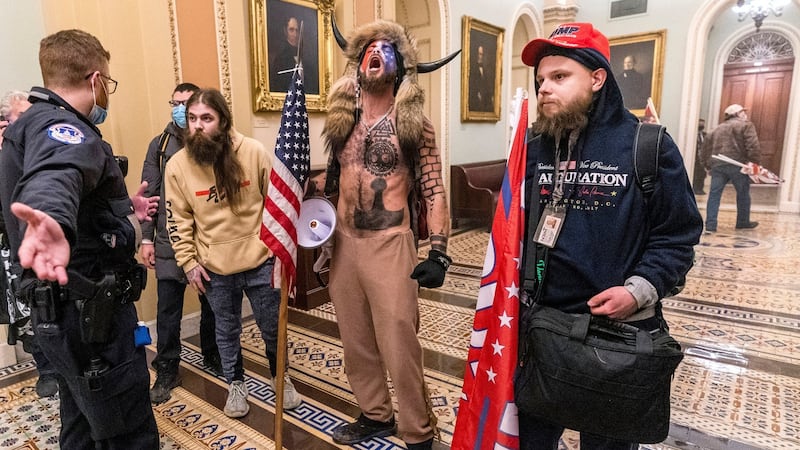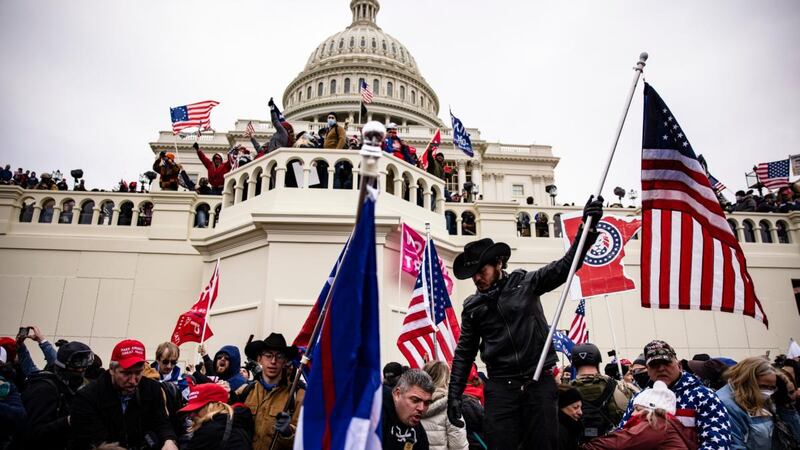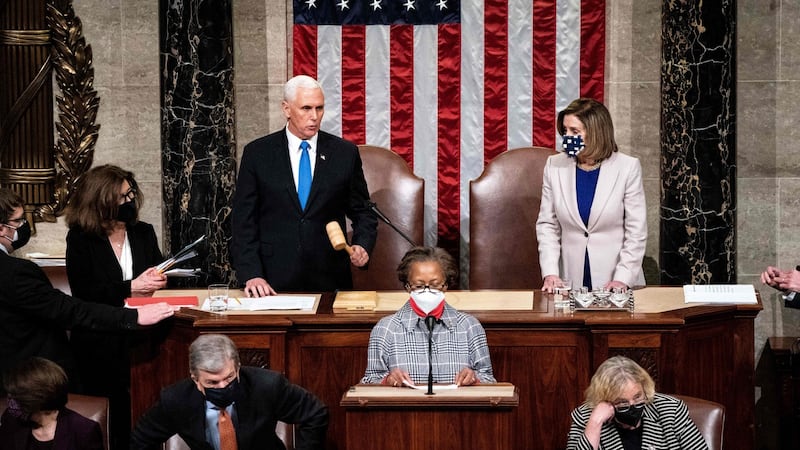“The hearings will tell a story that will really blow the roof off the House.”
So said Democratic Party politician Jamie Raskin when he promised in April that the forthcoming public hearings of the House of Representatives select committee would provide explosive revelations about what really went on behind the demonstrations at the US Capitol on January 6th last year.
The key question for the committee is whether the violence seen on the day was just a spontaneous outpouring of anger and frustration by supporters of a defeated candidate or whether there was an orchestrated attempt to frustrate the transfer of power following a legitimate election.
In other words, was there an attempted coup?
RM Block
And if so, (to coin a phrase from Watergate 50 year ago) what did former president Donald Trump know and when did he know it?
Democrats are certain that there was an attempted insurrection on January 6th.
At the weekend one of the two Republicans who serve on the January 6th committee, Liz Cheney, described the events of the day as a “conspiracy”.
“It is extremely broad. It’s extremely well-organised. It’s really chilling,” she said in an interview with US broadcaster CBS.
Cheney was last year jettisoned from the leadership of her party in the House of Representatives for her criticism of Trump. She said at the weekend there was “absolutely a cult of personality around Donald Trump” and that large sections of the Republican Party had bought into it.
She said she was confident the committee’s findings would grab the attention of the American people.
However, the committee hearings commence at a time when fewer Americans are blaming Trump for the events on January 6th.
An NBC poll earlier this week showed just 45 per cent of Americans now say the former president was “solely” or “mainly” responsible for the attack on the US Capitol – down seven per cent from the figure recorded in a similar poll in early 2021.
As the committee prepares to release its evidence, Trump has reportedly reached out to supporters in Congress and in the conservative movement to defend him.
Unlike the Watergate public hearings, on this occasion right-wing media on TV and radio in the US will also likely present a sceptical or counter-narrative to the committee’s revelations.
Fox News will not be showing the proceedings live for its three million prime time audience. It will continue with its comment-led programming with the committee hearings being broadcast on its business channel which attracts a fraction of the viewership.
******
The riots at the Capitol on January 6th, 2021, rocked American politics.
Unlike with other big violent events in the country, on this occasion politicians were not just left responding. They were witnesses. Some believed they may have been intended victims.

Some feared for the future of American democracy if the crowd of Trump supporters had blocked the certification of Joe Biden’s victory in the presidential election.
At the time it appeared that Trump’s spell over his Republican Party was on the verge of being broken. He was criticised personally by party leaders in Congress, who had seen his rioting supporters at first hand.
However, within a few weeks most of those in senior positions had fallen back into line. House minority leader Kevin McCarthy who, in a taped call, suggested he wanted Trump to resign, was standing shoulder-to-shoulder with the former president shortly afterwards at his Mar-a-Lago estate in Florida.
Republican senators, in the main, refused to support convicting him at his impeachment trial in the senate brought after January 6th. A conviction would have prevented Trump from holding office ever again.
The political calculation appeared to be that Trump still had the support of a large swathe of the party’s supporters. They needed Trump’s base to secure their own re-election and to drive their fundraising campaigns. For all his failings, to them on balance, it was better having Trump inside the tent that causing chaos outside it.
********
As riots, insurrections or attempted coups go, January 6th was probably the one for which the public had the most visibility.

There were probably hundreds of journalists and TV crews on the scene, virtually everyone had a camera phone and CCTV was everywhere.
In a broad sense what took place is widely known.
Thousands of Trump supporters violently attacked the Capitol building on the day when politicians were scheduled to confirm Joe Biden had won the election.
Rioters broke into the US Capitol and wandered through its hallways, many brandishing Trump memorabilia. At least one was carrying a confederate flag.
One police officer who was involved in trying to protect the building died shortly afterwards. Four others died by suicide in the following weeks and months.
About 140 police officers were injured. Some experienced concussions from blows from various objects, including metal poles ripped from nearby scaffolding, one with an American flag attached.
One Trump supporter was shot dead by police. Others died as a result of heart conditions and an accidental overdose.
The senate chamber was breached, and the desks and offices of politicians ransacked.
Senators and members of the House of Representatives as well as Trump’s vice-president were whisked to safety as his supporters chanted “hang Mike Pence” and built a makeshift gallows in the grounds outside.

The attack happened after Trump urged his supporters to come to Washington to demonstrate against the “big steal” – that the 2020 election had been rigged and the White House stolen from him.
No evidence of fraud was produced in dozens of court actions initiated by Trump after the election.
On the morning of January 6th, Trump addressed the crowds. Democrats have highlighted one phrase in which, they maintain, he effectively incited his followers: “We fight like hell. And if you don’t fight like hell, you are not going to have a country any more.”
Trump’s allies insist he also urged his supporters to behave “peacefully and patriotically”.
The committee set out to find out what was going on behind the scenes in Trump world – almost from the day of the election itself.
In a court filing in March the committee alleged that Trump and some of his allies were part of a “criminal conspiracy” aimed at overturning the 2020 election. It focused on Trump pressurising Pence to obstruct the certification of Biden’s victory.
“The president called and met state officials, met numerous times with officials in the department of justice, tweeted and spoke about these issues publicly, and engaged in a personal campaign to persuade the public that the election had been tainted by widespread fraud,” lawyers for the committee wrote in the court filing.
“The evidence supports an inference that president Trump and members of his campaign knew he had not won enough legitimate state electoral votes to be declared the winner of the 2020 presidential election during the January 6th joint session of Congress, but the president nevertheless sought to use the vice-president to manipulate the results in his favour.”
They maintained the conspirators also obstructed a lawful governmental function by pressuring the vice-president to violate his duty to count the electoral certificates presented from certain states.
“As an alternative, they urged the vice-president to delay the count to allow state legislatures to convene and select alternate electors.”
The committee will likely examine closely what Trump did and to whom he was speaking in the afternoon of January 6th in the White House as his supporters descended on the Capitol.
It is also likely to investigate why it took 187 minutes before national guard troops and additional police were sent to the Capitol to reinforce those who were battling with protesters.
The committee revealed in March there was a gap of more than seven hours in the official White House log of calls made by and to Trump on January 6th.
Cheney said in January that the committee had “first-hand testimony that he was sitting in the diningroom next to the Oval Office watching the attack on the Capitol on television.
She said Trump could have gone on TV and told his supporters to stop.
Not doing so, she said, was a “serious dereliction of duty”.
The January 6th committee has carried out about 1,000 interviews, reviewed 125,000 records including texts between top Trump administration officials, members of Congress, protesters and others.
The prime time public hearing on Thursday, which may be the first of possibly six such sessions, is likely to seek to set the story of the violence at the Capitol in the context of a broader, multi-pronged plot to overturn Biden’s electoral victory, with the alleged role of Trump himself running through the narrative.
The committee has promised new material. Video recordings of interviews carried out with Trump’s daughter Ivanka and her husband Jared Kushner will be watched closely.
The first hearing is expected to feature individuals who had dealings with the right-wing Proud Boys group about the January 6th events. Earlier this week, the US Department of Justice charged senior figures in this organisation with seditious conspiracy in relation to the attack on the Capitol.
Some allies of Pence are also likely to give evidence at some point. However, a key person to watch out for is Cassidy Hutchinson, a top aide to then-White House chief of staff Mark Meadows.
The Washington Post reported Hutchinson had told the committee that Meadows remarked to others that Trump indicated support for hanging his vice-president after rioters in the Capitol starting chanting: “Hang Mike Pence.”
It remains to be seen in what context any such evidence was given.
Meadows co-operated with the committee for a period but later ceased to do so. However, he provided the committee with a trove of over 2,000 text messages.
These included messages from members of Congress, Fox News presenters and others pleading for Trump to urge his supporters to stop the assault at the Capitol.
Other texts show Ginni Thomas, the wife of Supreme Court Justice Clarence Thomas, urging Meadows to take action to overturn the election result.






















